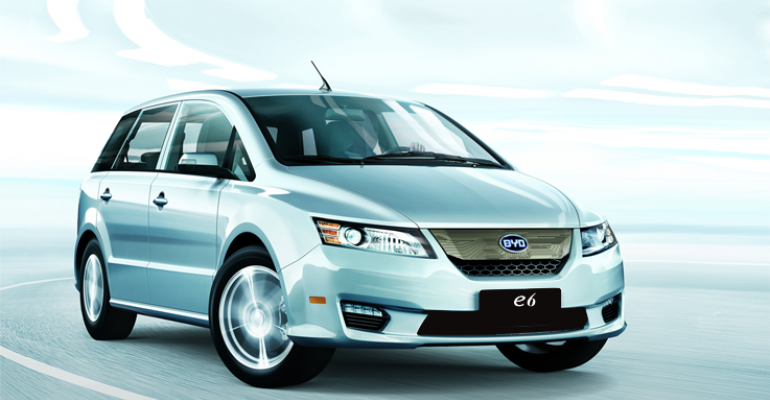WUHAN, China – Chinese automaker BYD first was known for its electric sedan, the e6.
But BYD Chairman Wang Chuanfu doesn’t discuss electric passenger vehicles in his opening remarks during a session on new-energy vehicles at last month’s Global Automotive Forum in this Central China city. He talks about buses.
Wang urges the U.S. and Europe to follow China’s example in setting policies to promote EV use in the public sector, including buses and taxis.
“The promotion of new-energy vehicles in the public sector is very effective,” he says.
New-energy vehicles include EVs and hydrogen-fuel-cell vehicles.
China quietly has changed course in its quest to have 5 million new-energy vehicles on the road by 2020. It now is more focused on electrifying municipal fleets. That is likely to significantly boost the number of EVs on the road, though not to the desired volumes.
According to Wang, buses and taxis comprise only 1.7% of all vehicles on the road in China but account for 25% of fuel consumption and up to 30% of emissions. BYD produces an electric bus it claims can go more than 170 miles (274 km) on a single charge.
The eastern city of Shenzhen, where BYD is headquartered, has many BYD electric buses and e6 electric taxis on its roads. There also are small numbers of both in municipal fleets globally, such as in the buses in the Los Angeles bus fleet and taxis in Hong Kong.
But in China local governments generally have been slow to go electric. When they do, they tend to buy buses made by local companies.
The central government aims to change that.
Earlier this year it declared 30% of all new purchases by municipal government should be new-energy vehicles, or NEVs. Crucially, the directive includes not only bus and taxi fleets but also garbage trucks, sanitation trucks, mail vans and the like.
The same pronouncement also requires at least 30% of the vehicles purchased be manufactured outside the local area.
There are carrots as well as sticks to encourage local fleets to go electric. For example, in 2013 the central government expanded subsidies for electric-bus purchases, which top off at RMB500,000 ($81,830) for a bus more than 32.8 ft. (10 m) long, to include shorter buses.
Wang sees electrification of public fleets as a way to expand charging infrastructure, which has lagged in China despite government directives to add charge points. That is because no one really knows how much usage the stations will get, he says in his remarks in Wuhan.
Use of fleet charge points is “guaranteed,” he says, and predicts more charging points for private owners will follow.
Public fleet electrification has been a goal in China since before the most recent policy directive. Indeed, bus electrification was included in a plan issued several years ago. That has already had an impact, according to McKinsey & Associates, which says 0.3% of buses on the road in 2011 were NEVs. By 2016, it predicts some 100,000 NEV buses in China.
“The China NEV market this year is growing, especially in buses,” says an executive at Wanxiang Group, one of China’s largest suppliers. It has an entire division devoted to producing EV components.
Passenger NEVs Still in the Picture
To be sure, there still are plenty of carrots to encourage consumers to buy NEVs.
The central government and some local governments offer hefty incentives for consumer purchases of NEVs. They are exempt from a 10% sales tax through 2017. Some local governments are offering free registration to buyers of NEVs.
Buyers of conventional gasoline- or diesel-powered cars often pay a high price in areas such as Shanghai, where a limited number of registrations are sold at auction each month for up to $15,000. American EV maker Tesla scored a coup by offering buyers free registration, a spiff that had been reserved for locally produced vehicles.
Wang says BYD hasn’t abandoned its e6 battery-electric vehicle but now is focusing on fleets. Small numbers of the EV are operating as taxis in cities around the globe.
For consumers, BYD is betting on its plug-in hybrid-electric vehicle, the Qin. The extended-range EV sold some 6.600 units in the first half of 2014, says Wang, who expects to sell 3,000 a month in 2015.
Almost all local automakers and joint ventures have announced plans to produce various kinds of EVs, although this is due more to central government pressure than to consumer demand.
Central government “encouragement” includes refusal to approve new production capacity unless some of the additional capacity is set aside for NEVs.
“Since a year ago many car makers are getting very nervous,” a China executive at a large multinational supplier said recently. “I observe activities again with NEVs for Chinese and joint-venture OEMs.”
Indeed, Volkswagen, which between its two JVs is China’s top car seller, says it will launch 20 new-energy vehicles in China, up from the 15 announced last November. The automaker expects to sell hundreds of thousands of NEVs in China by 2020, VW China chief Jochem Heizmann says.





